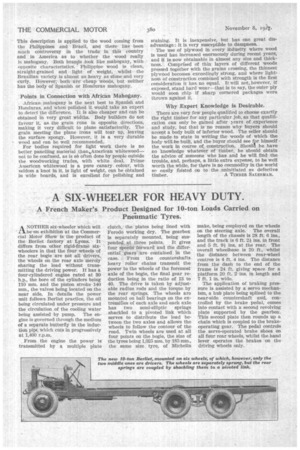A SIX-WHEELER FOR HEAVY DUTY.
Page 120

If you've noticed an error in this article please click here to report it so we can fix it.
A French Maker's Product Designed for 10-ton Loads Carried on Pneumatic' Tyres.
ANOTHER six-wheeler which will be on exhibition at the Commercial Motor Show is the product of the Berliet factory at Lyons. It differs from other rigid-frame sixwheelers in that the four wheels of the rear bogie are not all drivers, the wheels on the rear axle merely sharing the load without transmitting the driving power, it has a four-cylindered engine rated at 30 h.p., the bore of the cylinders being 110 mm. and the piston stroke 140 mm., the valves being located on the near side. In details the power unit follows Berliet practice, the oil being circulated under pressure and the circulation of the cooling water being assisted by pump. The engine is governed through the medium of a separate butterfly in the induction pipc which cuts in progressively at 1,400 r.p.m.
From the engine the power is transmitted by a multiple plate clutch, the plates being lined with Ferodo working dry. The gearbox is separately mounted, being suspended at three points. It gives four speeds forward and the differential gears are contained in the case. From the countershafts heavy roller chains transmit the power to the wheels of the foremost axle of the bogie, the final gear reduction being in the ratio of 13 to 40. The drive is taken by adjustable radius rods and the torque by the rear springs. The wheels are mounted on ball bearings on the extremities of each axle and each axle has two semi-elliptic springs shackled to a pivoted link which serves to distribute the load between the two axles and allows the wheels to follow the contour of the road. Twin wheels are used at all four points on the bogie, the size of the tyresbeing 1,025 nun, by 185 ram., the same size tyre, of Michelin
make, being employed on the wheels on the steering axle. The overall length of the chassis is 28 ft. 6 ins., and the track is 6 ft. 2 ins, in front and 5 ft. 91ins, at the rear. The overall wheelbase is 20 ft., whilst the distance between rear-wheel centres is 4 ft. 4 ins. The distance from the dash to the end of the frame is 24 ft. giving space for a platform 20 ft. 2-ins, in length and 7 ft. 1 in. wide.
The application of braking pressure is assisted by a servo mechanism, a hub plate being splined to the near-side countershaft and, controlled by the brake pedal, comes Into contact with a second revolving plate supported by the gearbox. This second plate then rounds up a chain which is coupled to the brakeoperating gear. The pedal controls the servo-operated brake shoes on all four rear wheels, whilst the hand lever operates the brakes on the driving wheels only.




















































































































































































